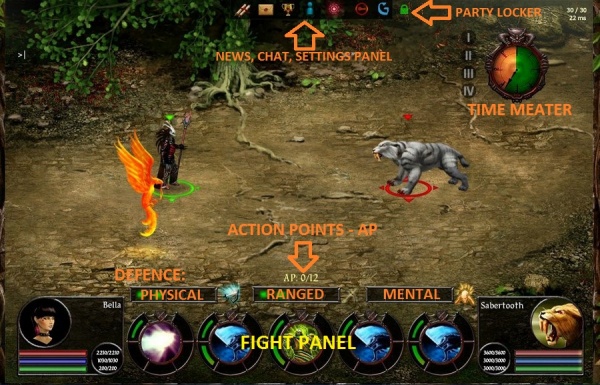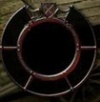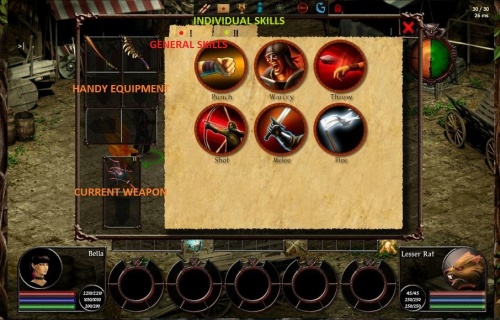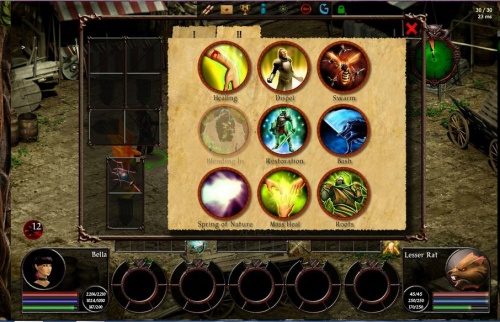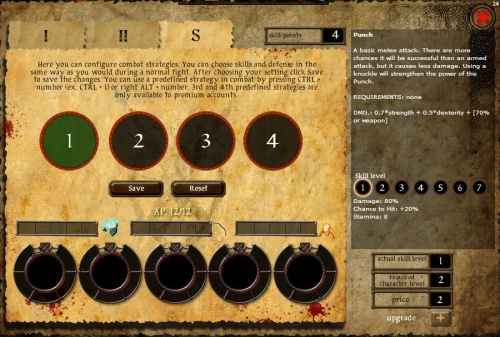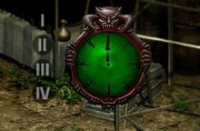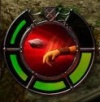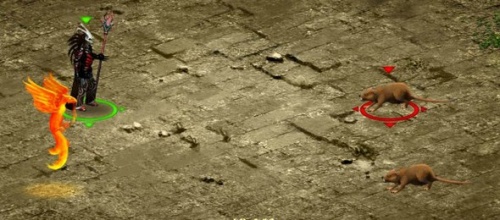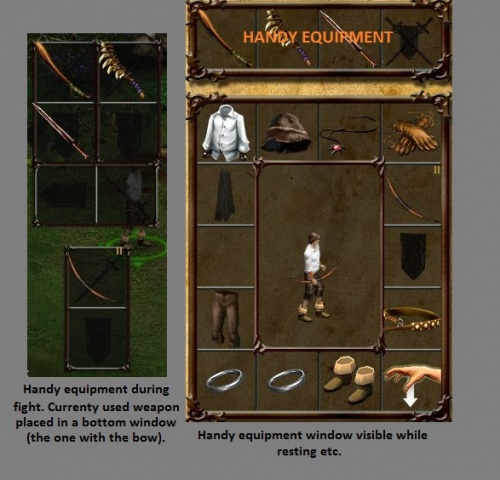Difference between revisions of "Combat - detailed description"
| Line 135: | Line 135: | ||
Aggressor: | Aggressor: | ||
| − | '''Formula: (40 + stats | + | '''Formula: (40 + stats + level) * AP * (AttMod) * SklMod''' |
* '''AP''' - the number of AP granted for the attack by the aggressor, each AP is enhancing the chance of successful attack of 20% | * '''AP''' - the number of AP granted for the attack by the aggressor, each AP is enhancing the chance of successful attack of 20% | ||
Latest revision as of 15:14, 10 March 2014
The fight in The Pride of Taern is a combination of a skill (you need to choose and set up your strategy as soon as possible using the available AP points) and a tactical game. We need to keep an eye on the fight so we can predict some of our enemy moves and plan our strategy for next round. Mainly close attention will help us to win the fight.
Fight is divided into rounds. At the beginning of each round we have 10 seconds to set our defence and attacks which we are willing to use. Each activity will cost us specific amount of the Action Point (we will call it AP from now on). Basically we do have 12 points to use, points are regenerated every round. Here you will have an example how to manage your first fight.
Contents
- 1 STEP I - Setting up your defence
- 2 STEP II - Getting ready for the attack
- 3 STEP III - Choosing the target
- 4 STEP IV - Settlement of the Round
- 5 Change of equipment
- 6 Type of attacks
- 7 Order of the attacks
- 8 What is responsible for the successful attack?
- 9 Is the amount of granted AP responsible for dealed damage?
STEP I - Setting up your defence
Defence points are responsible for blocking and avoiding the enemies attacks. In The Pride of Taern we have three different types of attacks:
- Physical
- Ranged
- Mental
For each kind of attacks we have 3 separate defences. At the beginning of the game the most important are the physical and ranged.
To set up your defence click on the boxes placed above the fight panel. For each type of defence we can use 0-5 AP. If we use 0 AP on one of the defences types, let's say on the ranged one, it means we are 100% receptive for all the ranged attacks. Each AP granted for it is enhancing the efficiency of our defence of 20%. Here is an example:
We are expecting our enemy to use a physical and ranged attacks so we have used 3 AP on the physical defence and 2 AP on the ranged one. We still have 7 AP which we will use now for attack.
STEP II - Getting ready for the attack
You can see your attacks presented on the bottom of the screen in small circles. One circle is designated for one activity.
To set up an attack we need to click on the circle. It will take us straight to the Skills panel. Skills panel is divided into 3 different parts.
I part is designated for all the basic attacks:
II part is designated for all the skills used by individual classes, as knight, healer etc.:
III part, available only from Skills before the fight, is designated for you. You can set up your own strategies here - two in general, three or four if you are in possession of one of the Premium Accounts:
After setting some strategies up, you can easly use it while fighting. Just need to click on one of the tiny circles next to the Time Meter:
Now you need to click on one of the skills you are going to use. It will show up in the circle and close the skills panel. In the middle of the circle you can see a picture of the choosed skill. Now you need to use some of your AP for the activity, You are doing it by clicking on the line around the circle. It works exactly the same as with defence - each granted AP will enhance the chance of successful attack of 20%. To make sure your attack is "active" you need to use at least 1 AP on it. Here is an example of the "Throw" with 4 AP used on it:
All the featured actions need to be repeated for each attack/spell used in fight. Please remember each circle is designated for separate activity. Here is an example of a filled Fight Panel:
STEP III - Choosing the target
After setting the defence and attacks up we need to choose our target. Our partners are highlited by a green coursor, our targets by the red one. All the positive skills will be directed to our partner, all the negative to the target. At the beginning of the fight team leaders are automatically marked as partners or targets.
STEP IV - Settlement of the Round
When the time is over we have a round. There is nothing to do at this stage, we can watch the fight. After the round we can use the same strategy or change defence or attacks.
Change of equipment
We are allowed to change our weapon while fighting. The gear which we want to use need to be previusly placed in the "handy equipment". You only need to move the weapon from one window to the other one (with the currently used weapon) during fight.
Type of attacks
Physical attack
Require the close contact with the target - all the melee attacks. Parameters influence:
- Hit: Dexterity
- Defence: Dexterity
Magical physical attack
Require the close contact with the target - all the attacks done by a magic classes (e.g. Arson, Bash). Parameters influence:
- Hit: Knowledge
- Defence: Dexterity
Physical Ranged Attack
Ranged attacks which require conventional weapons - stones, boulders, bows etc. It is also related to the ranged group attacks. Parameters influence:
- Hit: Dexterity
- Defence: Dexterity, Knowledge
Magical Ranged Attack
Ranged attacks caused by spells, e.g. Magical Spark, Fireball, Shadow Strike. It is also related to the ranged group attacks. Parameters influence:
- Hit: Knowledge
- Defence: Dexterity, Knowledge
Negative Spell
Mental attack, including all the negative spells used on your enemy as Warcry, Infection, Poisoning etc. It is also related to the negative group spells. Parameters influence:
- Hit: Knowledge
- Defence: Knowledge
Positive Spell
Mental attack, including all the positive spells used on your/partners character. It is also related to the positive group spells. Parameters influence:
- Hit: Knowledge
- Defence: N/A
Detailed description of all the skills you can find in game.
Order of the attacks
- Change of the weapons
- Effects of the previous round spells
- Inversion (special negative spell used outside of the order)
- Positive group spells
- Negative group spells
- Positive spells
- Negative spells
- Ranged group attacks
- Physical group attacks
- Ranged attacks
- Physical attacks
- Passed physical attacks
- Passed ranged attacks
- Passed negative spells
- Escapes
What is responsible for the successful attack?
Successful attack depends on the aggressor and the defender.
Aggressor:
Formula: (40 + stats + level) * AP * (AttMod) * SklMod
- AP - the number of AP granted for the attack by the aggressor, each AP is enhancing the chance of successful attack of 20%
- stats - Dexterity in a case of physical and ranged attacks, Knowledge in case of spells and magical ranged attacks
- SklMod - skills modifier
- AttMod - effects responsible for increasing or decreasing parameters
- level - current characters level
Defender:
Formula: (40 + stats + level) * AP * (DefMod)
- AP - the number of AP granted for each type of defence, each AP is enhancing the defence of 20%
- stats - Dexterity in case of the physical, ranged and magical ranged attacks, Knowledge in case of spells
- DefMod - effects responsible for increasing or decreasing parameters
- level - current characters level
Afterwards all the values are compared and the more percentage the aggressor will have the better chance for the successful attack.
The most important thing in here is the amount of granted AP. If the aggressor uses 1 AP on the attack and defender 5AP on the defence, aggressor will need to have over 5 times higher dexterity or knowledge to equalize the difference.
Is the amount of granted AP responsible for dealed damage?
No, it is not. The only things responsible for the dealed damage are the characters parameters and used skills in the attack. That is why it is better to carry out more attacks as you can break the defence with minimum amount of the AP used for it.
